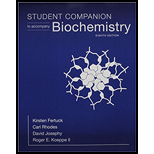
(a)
Interpretation:
The structure of D-Allose: Epimeric at C-3 should be determined.
Concept introduction:
Carbohydrates are a large group of organic compounds that are present in foods, living tissues. These include sugars, cellulose, and starch. Anomers are the glycosides or cyclic monosaccharides that are epimers. These are different from each other in the configuration of C-1 (aldoses) or at C-2 if (ketoses).
Answer to Problem 6P
The structure of D-Allose:

Explanation of Solution
When two sugars vary in their configuration around one carbon atom then those sugars are known as epimers of each other.
The structure of D-Allose: Epimeric at C-3 is given below:

(b)
Interpretation:
The structure of D-Altrose: Isomeric at C-2 and C-3 should be determined.
Concept introduction:
Carbohydrates are a large group of organic compounds that are present in foods, living tissues. These include sugars, cellulose, and starch. These are comprised of hydrogen and oxygen in a similar ratio as in water (2:1). They are usually broken down to release the energy in the animal body. These are of three types: monosaccharides, disaccharides, and polysaccharides.
Answer to Problem 6P
The structure of D-Altrose:

Explanation of Solution
Glucose is an aldose as it contains one
The structure of D-Altrose: Isomeric at C-2 and C-3 is given below:

(c)
Interpretation:
The structure of D-Mannose: Eplmeric at C-2 should be determined.
Concept introduction:
Carbohydrates are a large group of organic compounds that are present in foods, living tissues. These include sugars, cellulose, and starch. These are comprised of hydrogen and oxygen in a similar ratio as in water (2:1). They are usually broken down to release the energy in the animal body. These are of three types: monosaccharides, disaccharides, and polysaccharides.
Answer to Problem 6P
The structure of D-Mannose:
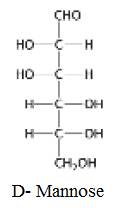
Explanation of Solution
Anomers are the glycosides or cyclic monosaccharides that are epimers. These are different from each other in the configuration of C-1 (aldoses) or at C-2 if (ketoses). In a pair of anomers, the anomer containing the alkoxy group or hydroxy group is pointing up on the anomeric carbon is known as the ß-anomer.
The structure of D-Mannose: Eplmeric at C-2 is given below:

(d)
Interpretation:
The structure of D- Gulose: Isomeric at C-3 and C-4
should be determined.
Concept introduction:
Carbohydrates are a large group of organic compounds that are present in foods, living tissues. These include sugars, cellulose, and starch. These are comprised of hydrogen and oxygen in a similar ratio as in water (2:1). They are usually broken down to release the energy in the animal body. These are of three types: monosaccharides, disaccharides, and polysaccharides.
Answer to Problem 6P
The structure of D- Gulose:

Explanation of Solution
Glucose is an aldose as it contains one aldehyde group per molecule in its acyclic form. Mannose is a sugar of the hexose group. It occurs as a constituent of several natural polysaccharides.
The structure of D- Gulose: Isomeric at C-3 and C-4 is given below:
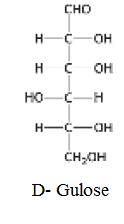
(e)
Interpretation:
The structure of D-Idose: Isomeric at C-2, C-3, and C-4 should be determined.
Concept introduction:
Carbohydrates are a large group of organic compounds that are present in foods, living tissues. These include sugars, cellulose, and starch. These are comprised of hydrogen and oxygen in a similar ratio as in water (2:1). They are usually broken down to release the energy in the animal body. These are of three types: monosaccharides, disaccharides, and polysaccharides.
Answer to Problem 6P
The structure of D-Idose:
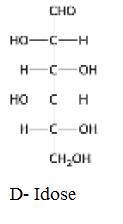
Explanation of Solution
Glucose is an aldose as it contains one aldehyde group per molecule in its acyclic form. Mannose is a sugar of the hexose group. It occurs as a constituent of several natural polysaccharides.
The structure of D-Idose: Isomeric at C-2, C-3, and C-4 is given below:
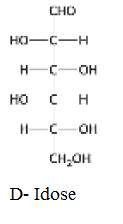
(f)
Interpretation:
The structure of D-Galactose: Epimeric at C-4 should be determined.
Concept introduction:
Carbohydrates are a large group of organic compounds that are present in foods, living tissues. These include sugars, cellulose, and starch. These are comprised of hydrogen and oxygen in a similar ratio as in water (2:1). They are usually broken down to release the energy in the animal body. These are of three types: monosaccharides, disaccharides, and polysaccharides.
Answer to Problem 6P
The structure of D-Galactose:
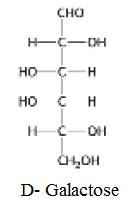
Explanation of Solution
Glucose is an aldose as it contains one aldehyde group per molecule in its acyclic form. When two sugars vary in their configuration around one carbon atom then those sugars are known as epimers of each other.
The structure of D-Galactose: Epimeric at C-4 is given below:
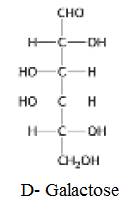
(g)
Interpretation:
The structure of D-Talose: Isomeric at C-2 and C-4 should be determined.
Concept introduction:
Carbohydrates are a large group of organic compounds that are present in foods, living tissues. These include sugars, cellulose, and starch. These are comprised of hydrogen and oxygen in a similar ratio as in water (2:1). They are usually broken down to release the energy in the animal body. These are of three types: monosaccharides, disaccharides, and polysaccharides.
Answer to Problem 6P
The structure of D-Talose:
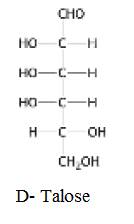
Explanation of Solution
Glucose is an aldose as it contains one aldehyde group per molecule in its acyclic form. When two sugars vary in their configuration around one carbon atom then those sugars are known as epimers of each other.
The structure of D-Talose: Isomeric at C-2 and C-4 is given below:

Want to see more full solutions like this?
Chapter 11 Solutions
Student Companion for Biochemistry
- functional groups in palmitic acid, a saturated fatty acid and oleic acid, an unsaturated fatty acidarrow_forwardα -Amylose is an unbranched glucose polymer. Why would this polymer not be as effective a storage form of glucose as glycogen?arrow_forwardBriefly explain why chicken fat, which largely consists of various triacylglycerols, has such a higher energy content per mole compared to sucrose.arrow_forward
- Rotation about the peptide bond in glycylalanine is hindered. Draw the resonance forms of the peptide bond and explain why.arrow_forwardChemistry For every 6 molecules of 3-phosphoglycerate produced by rubisco, _____ are converted to hexoses while _____ are recycled to ribulose-1,5-bisphosphate. 1; 5 2; 10 4; 8 6, 6arrow_forward. Explain what is meant by the term, “high energy compound”. Name a thioester molecule that is commonly found in biochemical reactions. Explain why thioesters are “high energy” compounds. Describe the molecular structure of cellulose. How does this structure explain why cellulose forms strong fibers? Explain why digestion of cellulose takes a long time even when catalyzed by an enzyme. The enzyme phosphofructokinase transfers a phosphate from ATP to the hydroxyl group a C1 of fructose. Similar to fructose, water also has a hydroxyl group and the concentration of water is much higher than that of fructose. Explain why the phosphate is transferred to fructose and not to water.arrow_forward
- In α-helices - what is the length of the hydrogen bonds between: TYR41H and GLU37O ALA39H and MET35O GLU38H and ILE34O THR36H and ARG32O. ARG32H and TYR28Oarrow_forwardMechanism of C1,C2-diether and C2-monoether derivatives of lycorine with explanationarrow_forwardName (systematic) and draw a 16-C unsaturated fatty acid with a single double bond in any position in trans configuration. Provide the chemical formulaarrow_forward
 BiochemistryBiochemistryISBN:9781305577206Author:Reginald H. Garrett, Charles M. GrishamPublisher:Cengage Learning
BiochemistryBiochemistryISBN:9781305577206Author:Reginald H. Garrett, Charles M. GrishamPublisher:Cengage Learning
